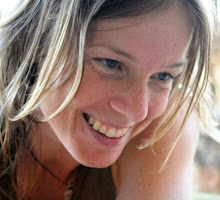
(Picture by Lisa Larsson)
I am standing in a deep kamae and Samuel is grabbing my wrist with a deep and strong, but still quiet, gyakuhamni katatedori. Katina is standing behind me, firmly holding my head with both hands, to keep my central axis straight. Jorma is standing on the side with his whole attention focused on the meeting between the two hands, as well as the dymanics of my upper body, as I initiate opening the door to the tai no tenkan. I fill my wrist with life and try to imagine that I move my hand deeply from the marrow of my bones, in a spiral movement forward, doing my best to facilitate Samuel in following. Samuel's grip is firmly attached, with the deepest contact from his Lao Gong point, but he is still free and flexible in his shoulders and arms and he is completely focused on keeping the contact between our hands. I focus on lowering my shoulder and letting the energy flow through my chest, but still, Jorma suddenly shouts "I see edge, I see edge! Go in there, wait and dissolve it..."
This a typical example of a situation during a deshi aikido practice with Jorma - one of many I have experienced. The goal with this exploration is to create an aikido that makes you feel good after every technique, and the edge he is talking about is representing every time you get a feeling of resistance in the grip or the rest of the body, a feeling of breaking loose or simply a very superficial and unconnected contact. Well, some of you might think, how has this soft and agreeing attitude got anything to do with budo? The fact is that it has everything to do with budo. The work uke does, at enhancing his presence and focus on being at the point, is exactly what later on enables you to follow freely when someone like Christian Tissier decides to express a lot of power in his shihonage, without you feeling any form of physical anxiety or pain from the ride. This is in the end a matter of being able to take care of yourself and the extension is of course that you can return with a new attack much sooner.
Using power of a different quality, or giving resistance through tensing parts of your body, has the same effect on the ki flow as road blocks on a highway. Traffic halts and the participants become filled with feelings of frustration and unpleasantness. On the other hand, when you occasionally, if even for a split second, find the point where there is a free flow, you get in contact with something that is higher than anything that can be explained by words and you are filled with a feeling of harmony and unity. This is what I believe is the essence of aikido and this particular point in space and time has healing properties on the ones that discover it.
If you study an animal, for example a dog, they can rest for hours, then suddenly wake up, and after a quick stretch they are fit to do whatever is on the menu. Their bodies are in a constant state of free flow and they never seem to become stale or tense. What differs us from the animals is first of all that our higher mental and emotional levels also give us the disadvantage that we accumulate more luggage, which in turn expresses itself psycho-somatically through tensions and blockings in our bodies. Our daily routines also prevents us from a natural movement pattern, but instead we compensate sitting at the office with physical exercise of different kinds that through its artificial nature many times exceeds the capacity of the body, which also creates unwanted physical symptoms. When I encounter an edge in the katatedori, I have to go all the way up to my shoulders to find the solution, or even sometimes deep down in my soul. This kind of work is of course all about building confidence and trust and without striving towards the same goal it will not be easy to to find the point where you are fulfilled with well-being, and what prevents us from doing the work is only our ego and preconceptions.
When two dogs play, they always know very well what are the boundaries, and this very fine-tuned perception can also be experienced when you yourself play with a dog. You can both increase the level of power used in the play, and this increase is always built on a mutual consent, but at the instant where the dog perceives a true discomfort from your part, at the same moment the dog will halt the play and instead show an interest in that you are OK and not hurt. This is a reflexive reaction that depends on a clear awareness and sensibility, and this ability has to a far extent been lost in the humans and this becomes especially clear in aikido practice, where physically strong persons often have a very tough time to truly understand their own strength and being able to meet a physically weaker partner with care and presence. For some people, even understanding the point with getting there, might be far-fetched. I wish for them to at some point experience the point of no resistance...






2 comments:
als anfänger, der ich bin, finde ich das beispiel mit den spielenden hunden sehr! angenehm. da kommt FREUDE auf .. :-)
Vielen dank, Frank!
Viel Glück bei der Aikido...
Post a Comment